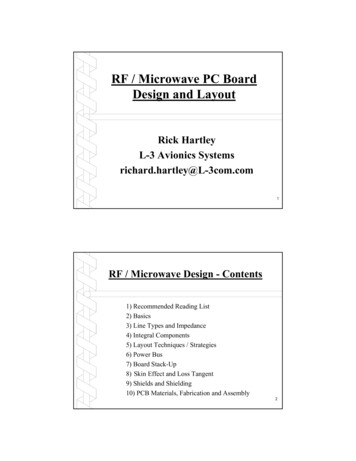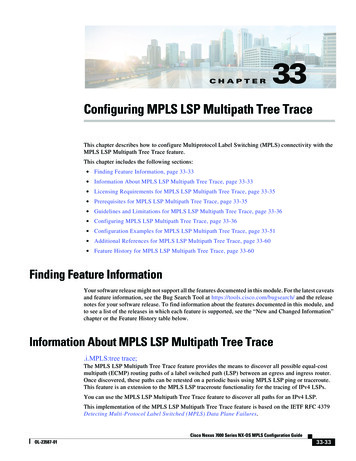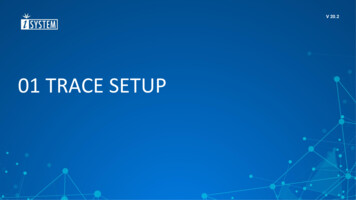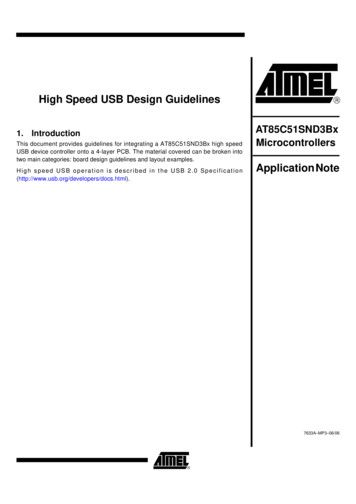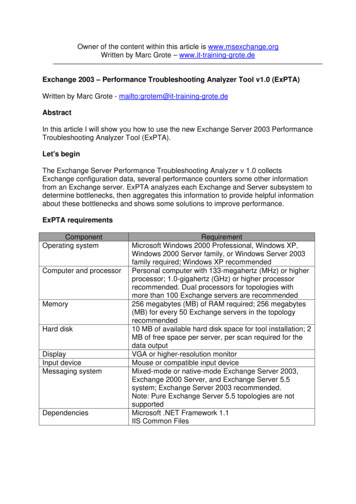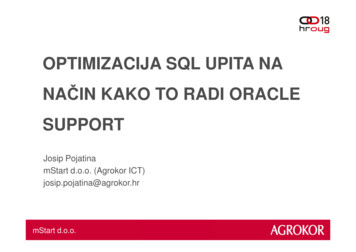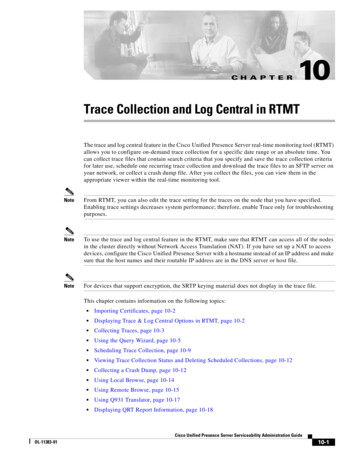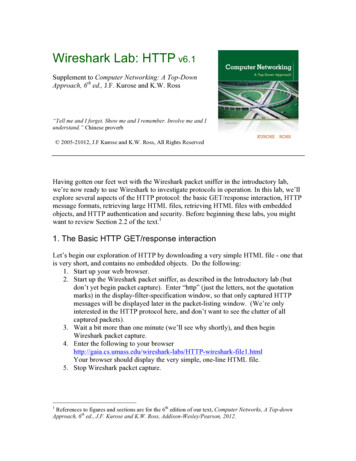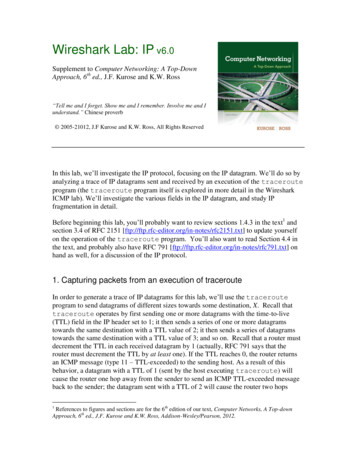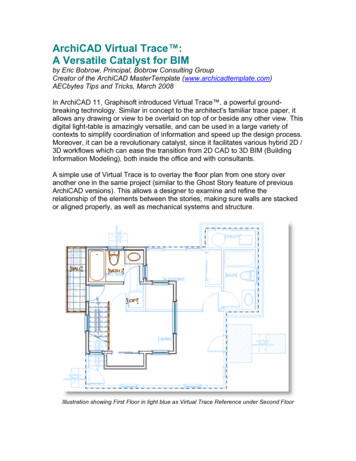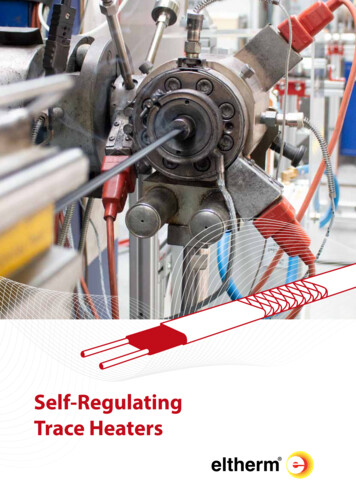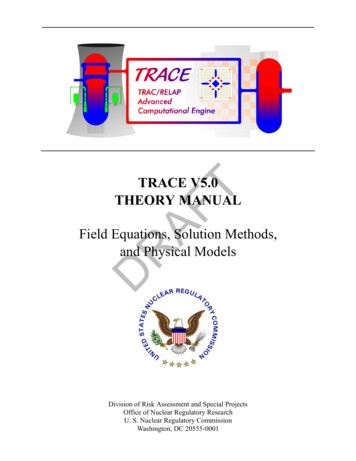
Transcription
AFTTRACE V5.0THEORY MANUALDRField Equations, Solution Methods,and Physical ModelsDivision of Risk Assessment and Special ProjectsOffice of Nuclear Regulatory ResearchU. S. Nuclear Regulatory CommissionWashington, DC 20555-0001
TAFDRThis page intentionally left blank
AcknowledgementsTMany individuals have contributed to the NRC code consolidation effort and to this manual, inparticular. In a project of this magnitude and complexity, and given the long histories of the NRCpredecessor codes and their associated manuals (from which this manual has evolved), it is ratherdifficult to sort out and keep track of each and every individual contribution of authorship.Rather than attempt to cite individual contributors to this particular manual (and run the risk ofexcluding somebody, either past or present), we simply acknowledge all known contributors tothe TRACE code development and assessment project, in general.RAFNuclear Regulatory Commission (NRC): Stephen Bajorek, Mirela Gavrilas, Chester Gingrich,James Han, Kevin Hogan, Joseph Kelly, William Krotiuk, Norman Lauben, Shanlai Lu,Christopher Murray, Frank Odar, Gene Rhee, Michael Rubin, Simon Smith, JosephStaudenmeier, Jennifer Uhle, Weidong Wang, Kent Welter, James Han, Veronica Klein, WilliamBurton, James Danna, John Jolicoeur, Sudhamay Basu, Imtiaz Madni, Shawn Marshall, AlexVelazquez, Prasad Kadambi, Dave Bessette, Margaret Bennet, Michael Salay, Andrew Ireland,William Macon, Farouk EltawilaDAdvanced Systems Technology and Management (AdSTM): Yue Guan, David Ebert, DukeDu, Tong Fang, Weidong He, Millan Straka, Don PalmroseApplied Programming Technologies (APT): Ken JonesApplied Research Laboratory/Penn State (ARL/PSU): John Mahaffy, Mario Trujillo, MichalJelinek, Matt Lazor, Brian Hansell, Justin Watson, Michael MeholicInformation System Laboratories (ISL): Birol Aktas, Colleen Amoruso, Doug Barber, MarkBolander, Dave Caraher, Claudio Delfino, Don Fletcher, Dave Larson, Scott Lucas, GlenMortensen, Vesselin Palazov, Daniel Prelewicz, Rex Shumway, Randy Tompot, Dean Wang, JaySporeLos Alamos National Laboratory (LANL): Brent Boyack, Skip Dearing, Joseph Durkee, JayElson, Paul Giguere, Russell Johns, James Lime, Ju-Chuan Lin, David PimentelPurdue University: Tom Downar, Matt Miller, Jun Gan, Han Joo, Yunlin Xu, TomaszKozlowski, Doek Jung Leeiii
TRACE V4.160Universidad Politecnica de Madrid: Roberto HerreroKorean Nuclear Fuel Co: Jae Hoon JeongDRAFTKorean Institute of Nuclear Safety: Chang Wook Huh, Ahn Dong Shiniv
TRACE V5.0Preface.xvOverview of TRACE .xvTRACE Characteristics. xviiMulti-Dimensional Fluid Dynamics . xviiNon-homogeneous, Non-equilibrium Modeling. xviiFlow-Regime-Dependent Constitutive Equation Package . xviiComprehensive Heat Transfer Capability. xviiiComponent and Functional Modularity . xviiiPhysical Phenomena Considered . xviiiLimitations on Use. xixIntended Audience .xxOrganization of This Manual . xxiTReporting Code Errors . xxiAFConventions Used in This Manual. xxii1: Field Equations .1Nomenclature.2Fluid Field Equations.6RRearrangement of Equations for Numerical Solution.14Noncondensable Gas.16DLiquid Solute.17Application Specific Usage of these Equations .181-D Equations .18Pseudo 2-D Flow .203-D Equations .21Basic Finite-Volume Approximations to the Flow Equations .21Time Level Selection .32Basics of the Semi-Implicit Method .35Enhancements to the Semi-Implicit Method .37Semi-Implicit Method Adapted to Two-Phase Flow .39Basics of the SETS Method .43Enhancements to the SETS Method .46The SETS Method Adapted to Two-Phase Flow.48v
TRACE V5.03D Finite-Difference Methods .58Modifications to the Basic Equation Set.66Conserving Convected Momentum .67Reversible and Irreversible Form Losses.71Special Cases .71References.752: Solution Methods.77Nomenclature.77Overall Solution Strategy.79Basic Solution Methodology .80Solution of the 1D Stabilizer Motion Equations.80TSolving the SETS Semi-Implicit Step.83Solution of the SETS Stabilizer Mass and Energy Equations .88AFFinal Solution for a New-Time Void Fraction .88Considerations for 3D Solutions.90The Capacitance Matrix Method .93Water Packing .96R3: Heat Conduction Equations.99DNomenclature.99Governing Equations .101Coupling of Thermal Hydraulics with the Reactor Structure .102Cylindrical Wall Heat Conduction.105Slab and Rod Heat Conduction.106The Lumped-Parameter Solution.107The Semi-Implicit Calculation.108The Fully Implicit Calculation.112Fine-Mesh Algorithm. .115References.1184: Drag Models.119Nomenclature.119Interfacial Drag .123vi
TRACE V5.0Pre-CHF Interfacial Drag Models.124Stratified Flow Interfacial Drag Models .148Post-CHF Interfacial Drag Models .157Wall Drag .170Single-Phase Friction Factor.171Pre-CHF Regimes: Two-Phase Multiplier .173Horizontal Stratified Flow Model .182Post-CHF Flow Regimes .184References.1875: Interfacial Heat Transfer Models .193Nomenclature.193TIntroduction.197Pre-CHF Interfacial Heat Transfer Models.200AFBubbly Flow Regime .200Cap Bubble/Slug Flow Regime .204Modifications for Subcooled Boiling .207Interfacial Heat Transfer Models for the Annular/Mist Flow Regime .208RInterpolation Region .215Flashing Model .216DStratified Flow Interfacial Heat Transfer Models .216Transition to Non-Stratified Flow.219Post-CHF Interfacial Heat Transfer Models .219Inverted Annular .220Inverted Slug.224Dispersed Flow .226Interpolation Region .228Transition to Pre-CHF Regimes.229Non-Condensable Gas Effects .229Default Model for Condensation .230Special Model for Film Condensation .232Model for Evaporation.238References.240vii
TRACE V5.06: Wall Heat Transfer Models .245Nomenclature.245Introduction.250Pre-CHF Heat Transfer .252Single-Phase Liquid Convection .252Two-Phase Forced Convection .263Onset of Nucleate Boiling.267Nucleate Boiling .271Subcooled Boiling Model .278Critical Heat Flux.282AECL-IPPE CHF Table.284CISE-GE Critical Quality .292TBiasi Critical Quality .293AFMinimum Film Boiling Temperature.295Post-CHF Heat Transfer.302Transition Boiling .302Inverted Annular Film Boiling .308RDispersed Flow Film Boiling.316Inverted Slug Film Boiling .336DCondensation Heat Transfer.338Film Condensation .338Dropwise Condensation .346Non-Condensible Gas Effects.347References.3517: Flow Process Models.359Nomenclature.359Critical Flow .362Subcooled Liquid .363Two-Phase, Two-Component Fluid .367Single-Phase Vapor .373Transition Regions .373Cell-Center Momentum-Solution Velocities .374viii
TRACE V5.0New-Time Choking Velocities.374Determining the Sound Speed .375Countercurrent Flow .376CCFL in the 3D VESSEL .376The Model.377Input Scheme .378Level Tracking .379Level Tracking Method.380Modifications To The Field Equations .382Mass and Energy Equations.382Momentum Equations.385Corrections to Evaluation of the Closure Models.388TInterfacial Drag .388Interfacial Heat and Mass Transfer.390AFNumerical Experiments .392Fill and Drain Test .392Oscillating Manometer .396RExpulsion of Superheated Steam by Subcooled Water.404Summary of the Simulations.412DOfftake Model.412Form Loss Models .416Abrupt Expansion .421Abrupt Contraction .422Thin-Plate Orifice .424Models as Coded.425References.4278: Fuel Rod Models.431Nomenclature.431Nuclear Fuel Mixed-Oxide Properties .434Fuel Density .434Specific Heat.435Fuel Thermal Conductivity .436ix
TRACE V5.0Fuel Spectral Emissivity .437Fuel Rod Gap Gas Properties.438Zircaloy Cladding Properties .441Cladding Density .441Cladding Specific Heat .442Cladding Thermal Conductivity .443Cladding Spectral Emissivity.444Fuel-Cladding Gap Conductance.445Fuel - Cladding Gap Dimension .446Metal - Water Reaction .449References.450T9: Reactor-Core Power Models .453Nomenclature.454AFPartitioning of the Core Power into the Heat-Conduction Mesh.458Power Evaluation and Reactor Kinetics .467Point-Reactor Kinetics .467Default Data for the Delayed-Neutron Groups.469RDefault Data for the Decay-Heat Groups.470Fission Power History.471DReactivity Feedback.471Solution of the Point-Reactor Kinetics .480Conclusions Regarding the Reactor-Core Power Model .487References.48810:Special Component Models .491Nomenclature.491PUMP Component .496Pump Governing Equations .496Pump Head Modeling .498Pump Torque Modeling .501Pump Speed .502Pump Friction Heating.503x
TRACE V5.0PRIZER Component .504Collapsed Liquid Level.505Heater/Sprays.506SEPD Component .507Definitions .510Conceptual Structure of the SEPD Component .511Assumptions.511Fundamental Analytical Model .512Mechanistic Separator Modeling .517Dryer Modeling.525JETP Component .527References.533T11:Fluid Properties .535AFNomenclature.535Thermodynamic Properties.536Saturation Properties.537Liquid Properties.547RSteam Properties .551Noncondensable Gas (Air, Hydrogen, or Helium) Properties .558DSteam-Gas Mixture Properties .561Transport Properties.561Latent Heat of Vaporization .562Constant-Pressure Specific Heat.562Fluid Viscosity .564Fluid Thermal Conductivity.569Surface Tension.571Liquid Solute Properties .572Model Description .572Verification.574Verification of Boron Solubility Model .580References.
This manual is one of three manuals that comprise the basic TRACE documentation set. The other two are the Users' Manual and Developmental Assessment Manual. Overview of TRACE TRACE has been designed to perform best-estimate analyses of loss-of-coolant accidents
